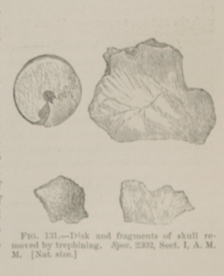Title: M——, M.
Source text: Surgeon General Joseph K. Barnes, United States Army, The Medical and Surgical History of the War of the Rebellion. (1861–65.), Part 1, Volume 2 (Washington, D.C.: Government Printing Office, 1870), 265.
Civil War Washington ID: med.d1e16691
TEI/XML: med.d1e16691.xml
CASE.—Private M. M——, Co. C, 48th Pennsylvania Volunteers, aged 45 years, was wounded at the battle of Spottsylvania Court-house, Virginia, May 12th, 1864, by a conoidal ball, which comminuted and depressed the left parietal bone near the upper border to the left of the longitudinal sinus. He was admitted to the hospital of the Ninth Corps and thence sent to the Carver Hospital, Washington, on the 14th, somewhat morose and taciturn, and at times manifesting slight symptoms of compressions, but expressing himself quite intelligibly. On the evening of the 15th, he became decidedly comatose. On the following morning the patient was placed under the influence of ether. Acting Assistant Surgeon J. O. French trephined the skull over the affected region and removed several large splinters of the external table. The depressed portion was of an irregular quadrangular shape, measuring an inch or more in its longest diameter, and was firmly imbedded in the brain. The membranes and medullary substance of the brain were lacerated by the depressed fragments, accounting for the slight oozing of medullary substance and blood that had existed ever since his admission. Considerable hæmorrhage occurred during the operation, which was controlled by dry lint. The operation relieved the patient from his comatose condition, and he became quite animated, remaining so until the 18th, when coma again set in. Death supervened on the 20th. The autopsy revealed traces of meningeal inflammation and infiltration of purulent matter in the region of the injury. The left lateral ventricle was distended with blood, and a small piece of bone was found projecting into its cavity. The pathological specimen is a disk and three fragments of bone, removed from the cranium. The largest fragment is from the inner table and measures one inch in diameter. The specimen and history were contributed by Surgeon O. A. Judson, U. S. V.
